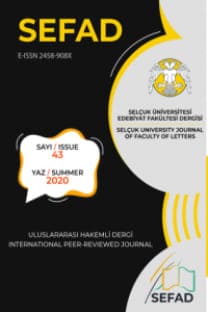THE IMAGE OF THE BULLFIGHT AND BULLFIGHTER IN 20TH CENTURY SPANISH POETRY: LORCA'S ELEGY LAMENT FOR IGNACIO SÁNCHEZ MEJIAS
20. YÜZYIL İSPANYOL ŞİİRİNDE BOĞA GÜREŞİ VE MATADOR İMGESİ: LORCA'NIN IGNACIO SÁNCHEZ MEJIAS'A AĞIT ÖRNEĞİ
___
- BENITO LOBO, José Antonio (2000). Literatura para la vida, Madrid: Edinumen.
- BOADO, Emilia - CEBOLLA, Fermin (1976). Las señoritastoreras, Madrid: Felmar.
- CLARAMUNT LÓPEZ, Fernando (2011). Antología de Escritos Taurinos, Vol.1, Valencia, 2011.
- CORROCHANO, Gregorio (1969). De como se debenver las corridas de toros, Los Torosen España, Tomo 1, Dir. Carlos Orrellana, Madrid: Editorial Orel.
- DELGADO RUIZ, Manuel (1986). De la muerte de undios, Barcelona: Nexos.
- DOMINIQUE, Lapierre - Collins, Larry (1993). YasımıTutacaksın, İstanbul: Payel.
- FREUD, Sigmund (1917). "Mourning and Melancholia", The Standard Edition of the Complete Psychologica Works of Sigmund Freud, Volume XIV.
- GARCIA LORCA, Federico (1942). "Teoría y juego del duende", Obras Completas, 7, Buenos Aires: Losada.
- GARCÍA LORCA, Federico. ''Lament for Ignacio Sánchez Mejíllas'', (Traduced by A.S.Kline), http://www.poetryintranslation.com/PITBR/Spanish/FiveintheafternoonLorc a.htm(25.10.2015).
- HONIG, Edwin (1941). ''The Poetry of Federico García Lorca'', New Mexico Quarterly Review, No: 4, November, Volume XI, pp. 389-413.
- LÓPEZ IZQUIERDO, Francisco (1972). Torosen Segovia, Segovia: Publicaciones de la Cajade Ahorros de Segovia.
- MARÍA DE COSSIO, Jose (2007). Los Toros: Literatura y periodismo, 8, Madrid: Edelsa.
- MONTES PAQUIRO, Francisco (1969).De Arte de torear, Los TorosenEspaña, Tomo 1, Dir. Carlos Orellana, Madrid: Editorial Orel.
- ORR, Gregory (2002). Poetry as Survival, Athens: University of Georgia Press. RÍOS RUIZ, Manuel (1990). Aproximación a la Tauromaquía, Madrid: Istmo.
- SACKS, Peter (1985). The English Elegy: Studies in the Genre from Spenser to Yeats, Baltimore: Johns Hopkins University Press.
- TORO BUIZA, Luis (1947). Sevillaenla historia del toreo, Sevilla: Ayuntamiento de Sevilla.
- TORO BUIZA, Luis (1969). Posiblesorígenes del arte del toreo, Los TorosenEspaña, Tomo 1, Dir. Carlos Orellana, Madrid: Editorial Ore.
- TRUJILLO, Jose Antonio (1981). Los torosen la literatura, A. Santiago Orozco, lidiadoren las ondas y maestro de la críticataurina, Madrid: Impreso de España.
- YENER GÖKŞENLİ, Ebru (2011). İç Savaş Sonrası İspanyol Romanına Yansıyan Tarihsel, Toplumsal ve Sosyal Çeşitliliğin İncelenmesi, (Analysis of thehistorical and social variety reflected on the Spanish Post-War Novel), Istanbul: University of Istanbul, Institute of Social Sciences, (Published PHD Thesis).
- Yayın Aralığı: 2
- Başlangıç: 1981
- Yayıncı: Selçuk Üniversitesi Edebiyat Fakültesi
AYAZ İSHAKİ'NİN ÜYGE TABA (EVE DOĞRU) ROMANINDA MİLLÎ VE DİNÎ UYANIŞ
BEYÂNÎ-ZÂDE AYÂNÎ'NİN GAZELLERİ
BÜYÜSÜ BOZULMUŞ DÜNYAYI BÜYÜLEMEK
15. YÜZYIL ŞAİRLERİNDEN DİYARBAKIRLI HALÎLÎ'NİN ŞİİRLERİ
DİYARBAKIR ZİYA GÖKALP YAZMA ESER KÜTÜPHANESİNDEKİ NAHVE DAİR YAZMA ESERLER BİBLİYOGRAFYASI
RICHARD SENNETT'İN ÇALIŞMALARINDA TOPLUMSALLAŞMANIN BAZI REFERANS ALANLARI VE MODERNLİK
